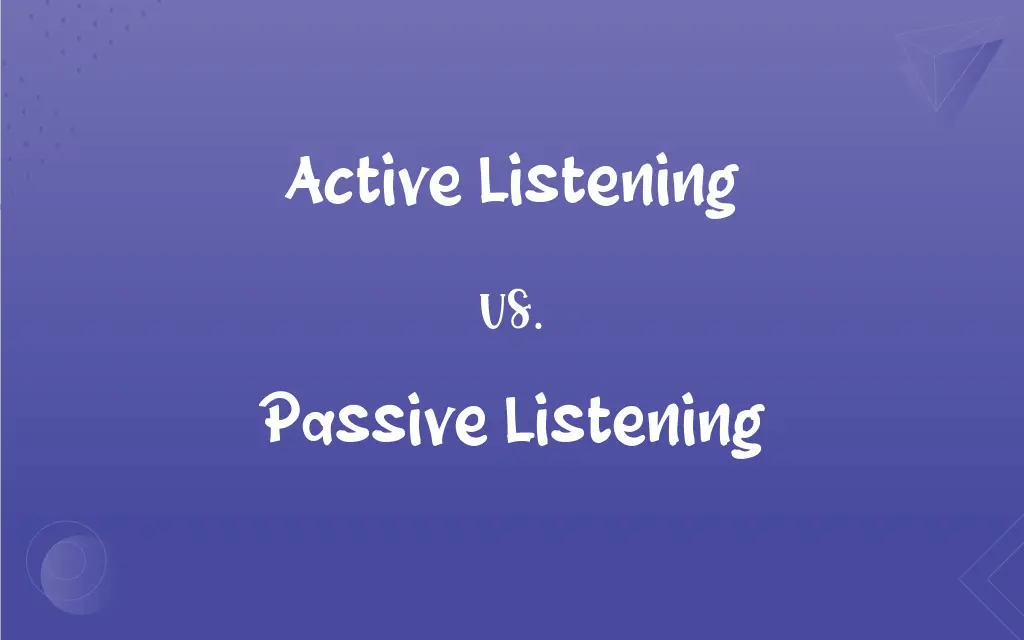Active Listening vs. Passive Listening: What's the Difference?
Edited by Janet White || By Harlon Moss || Updated on October 3, 2023
Active listening involves fully focusing, understanding, and responding to a speaker, while passive listening entails hearing without fully engaging or responding.

Key Differences
Active listening encompasses deliberate focus, concentration, and engagement during communication, facilitating in-depth understanding and response. Passive listening, on the other hand, is characterized by a lack of intentional focus and often results in superficial comprehension and minimal, if any, response.
The practice of active listening necessitates conscious effort, such as providing feedback, asking clarifying questions, and demonstrating attentiveness through verbal and non-verbal cues. Conversely, passive listening requires no such deliberate actions and typically involves merely hearing without significantly engaging or interacting.
Active listening promotes an interactive communication style, wherein the listener actively engages in the discussion and often leads to a more meaningful exchange. Passive listening usually results in a one-sided conversation where the listener receives information without necessarily participating in the exchange or ensuring understanding.
In active listening, empathetic understanding and genuine attention are predominant, fostering a supportive communication environment. In contrast, passive listening is characterized by a disconnected communication style, where the listener may miss nuances and emotional cues, potentially leading to miscommunications and a lack of understanding.
Active listening encourages effective communication and typically fosters positive relationships and constructive discussions. Passive listening can, however, lead to misunderstandings, neglected relationships, and a potential breakdown in communication due to its inherently unengaged and non-interactive nature.
ADVERTISEMENT
Comparison Chart
Point of Difference
Active Listening
Passive Listening
Engagement Level
High, with focus and response
Low, without deep engagement
Interaction
Interactive and responsive
Minimal or no interaction
Requirement
Effortful and intentional
Requires little to no effort
Effect on Communication
Enhances communication
May hinder communication
ADVERTISEMENT
Emotional Understanding
Typically high
Typically low or none
Active Listening and Passive Listening Definitions
Active Listening
Active listening involves fully concentrating on the speaker.
She practiced active listening by maintaining eye contact and nodding as her friend spoke.
Passive Listening
Passive listening does not involve providing feedback to the speaker.
His lack of questions and feedback showcased passive listening.
Active Listening
Active listening encompasses asking questions for clarification.
Her active listening was displayed by asking insightful questions to understand better.
Passive Listening
Passive listening involves hearing without fully engaging.
His passive listening during the lecture was evident as he did not recall key points afterward.
Active Listening
Active listening includes providing feedback to the speaker.
His active listening was evident when he summarized the speaker's points for clarity.
Passive Listening
Passive listening lacks a conscious effort to understand deeply.
Her passive listening during the meeting resulted in missing essential details.
Active Listening
Active listening entails showing empathy towards the speaker.
Through active listening, she conveyed empathy by mirroring the speaker’s emotions.
Passive Listening
Passive listening does not seek to empathize or relate to the speaker.
His passive listening led to a lack of emotional understanding of the speaker’s experience.
Active Listening
Active listening requires the listener to avoid forming responses while the speaker is talking.
He demonstrated active listening by not interrupting with his thoughts until she was finished speaking.
Passive Listening
Passive listening omits the deliberate decoding of the speaker's message.
She practiced passive listening, absorbing words without processing their meaning.
FAQs
What is the primary goal of active listening?
The primary goal of active listening is to fully understand and engage with the speaker.
Why might someone engage in passive listening?
Someone might engage in passive listening when they are distracted, uninterested, or multitasking.
How can I improve my active listening skills?
Enhance active listening by maintaining eye contact, avoiding interruptions, asking questions, and providing feedback.
How can active listening impact relationships?
Active listening can strengthen relationships by demonstrating care, understanding, and genuine interest in others.
Are there benefits to passive listening?
Passive listening can be beneficial when multitasking or when detailed understanding isn't crucial, like listening to background music.
Can passive listening be appropriate in some situations?
Yes, passive listening can be suitable for situations like overhearing casual conversations or when relaxation is the goal.
Is passive listening the same as ignoring?
No, passive listening involves hearing without deep engagement, while ignoring is intentionally not listening.
How can body language contribute to active listening?
Positive body language, like nodding and maintaining eye contact, can enhance active listening by showing attentiveness.
What's a common misconception about active listening?
A misconception is that active listening means agreeing. In fact, it's about understanding, not necessarily agreeing.
Can passive listening lead to misinformation?
Yes, since passive listening lacks in-depth engagement, it can result in misunderstandings or misinterpretations.
Is it exhausting to always practice active listening?
While active listening requires effort, consistent practice can make it more natural, though breaks might be needed in lengthy discussions.
Can passive listening be a conscious choice?
Yes, one might consciously choose passive listening in situations where full engagement isn't necessary or desired.
Can you actively listen to multiple people simultaneously?
It's challenging to actively listen to multiple people at once, as active listening requires focused attention.
How does active listening differ from hearing?
Active listening involves understanding and processing, while hearing is just the reception of sound.
What are some barriers to active listening?
Barriers can include distractions, biases, external noise, or emotional reactions.
How can active listening benefit workplace communication?
Active listening can lead to clearer communication, fewer errors, improved teamwork, and a more positive workplace environment.
What roles do feedback and reflection play in active listening?
Feedback and reflection are crucial in active listening as they ensure understanding and show the speaker they're being heard.
How can I identify if someone is passively listening to me?
Indicators of passive listening might include a lack of feedback, minimal eye contact, and apparent distraction.
Are there risks to consistently practicing passive listening?
Yes, consistent passive listening can lead to misunderstandings, missed information, and strained relationships.
Is taking notes a form of active listening?
Yes, taking notes can be part of active listening as it involves actively processing and recalling the information.
About Author
Written by
Harlon MossHarlon is a seasoned quality moderator and accomplished content writer for Difference Wiki. An alumnus of the prestigious University of California, he earned his degree in Computer Science. Leveraging his academic background, Harlon brings a meticulous and informed perspective to his work, ensuring content accuracy and excellence.
Edited by
Janet WhiteJanet White has been an esteemed writer and blogger for Difference Wiki. Holding a Master's degree in Science and Medical Journalism from the prestigious Boston University, she has consistently demonstrated her expertise and passion for her field. When she's not immersed in her work, Janet relishes her time exercising, delving into a good book, and cherishing moments with friends and family.
































































